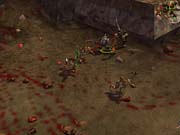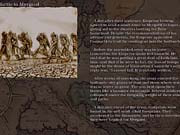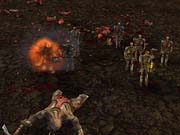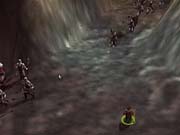When Bungie's Myth: The Fallen Lords came out at the end of 1997, it represented a radical new direction for real-time strategy games. The game was purely tactical, excluding resource gathering and production and instead emphasizing the importance of each unit and of carefully maneuvering troop formations. Rolling 3D terrain, a detailed physics engine, and graphic special effects made for intense fast-paced combat with real depth and intricacy. What tied it all together was a strong epic storyline in the single-player campaign and a lively multiplayer community revolving around Bungie.net, Bungie's gaming service. Myth III: The Wolf Age follows directly in the footsteps of the two games preceding it and adds 3D character models and many new units. Despite some rough edges in the multiplayer launch and compatibility problems with Windows XP, Myth III's single-player game represents the best the Myth series has to offer. Featuring great graphics, a memorable story, and plenty of diverse missions, Myth III's campaign will present a welcome challenge for veterans and newcomers alike.

Myth III is the first full game in the series to appear since Take-Two acquired the franchise as a part of
Myth III pulls together familiar pieces from the high fantasy tradition--you'll find dwarven smiths, fierce barbarians, legions of undead, and ancient relics of power--and mines nearly all the first games' back story to create a what would be a page-turning epic if it were in book form. The Fallen Lords, introduced in the first game as fallen heroes risen to lead the forces of darkness, have always been an intriguing cast of characters with a surprising amount of personality, including personal ambitions and old vendettas among themselves. Myth III takes place 1,000 years before the previous games, in the time when some of the Fallen Lords were actually heroes for the forces of good. Veterans of the series will quickly recognize the Fallen Lords Balor, Soulblighter, Shiver, and the Deceiver in Myth III as the heroes Connacht, Damas, Ravanna, and Myrdred, respectively. These characters have new lives all their own, and most of the game's missions include one of them to help you. Because of the power these heroes bring to your side, the forces of light prove much more interesting and well equipped than before. But that's not to say that the forces of darkness are at a disadvantage. Moagim, the faceless one, serves as a suitably terrible and formidable opponent throughout the game.

True to its early promises, Mumbo Jumbo has changed almost nothing about Myth's core gameplay, only adding new units, maps, and missions. This is good news that means the existing game balance remains intact. Nonetheless, the Myth games have a gameplay style so different from that of other real-time strategy games that it takes some getting used to for players who haven't experienced the series before. The story-based missions give you a set group of troops--typically some mix of melee, ranged, and spell units--to use against the computer-controlled forces that are scripted to attack at particular times or places. But while the number and starting places of your undead opponents remains the same between different tries at a given mission, the artificial intelligence is scripted to generally react well to the changing threat you pose. Only occasionally do missions give you reinforcements to cover your troop losses mid-mission, so even if you win a given engagement, you might need to change tactics and replay it to get more of your troops to their final objective. Coordinating formations of different units is an important key to victory, and the single-player game can be slowed down to half-speed to make it easier to micromanage the fast-paced battles. At the lowest level of difficulty, the 25 missions are still quite involved. The challenge rises considerably at the medium "mighty" setting and the nearly impossible "legendary" setting, so at least the most interesting missions are worth replaying, either by yourself or online, with the co-op multiplayer option.
There are more new units in Myth III than were added in Myth II. Instead of the different good-aligned races contributing just one unit type to a ragtag horde, most races are now well represented by two or three unit types. This helps the missions make more sense. A band of Molotov-cocktail-throwing dwarves can now be supported by surly dwarven axemen and even stocky flamethrower-wielding troops. The unit diversity helps the missions focus on dealing with individual factions of the dark horde, such as the swift myrkridia--now with their own giant units and lightning-bolt-casting mages. The trow, walking mountains that they are, come in new forms as well. The move to 3D units has also allowed Mumbo Jumbo to make the trow just as huge and imposing onscreen as you'd expect them to be.
Myth III's minimal interface is nearly identical to that of Myth II. The short tutorial--unfortunately somewhat hidden in the missions list rather than readily apparent on the main menu--provides a quick way to get familiar with how Myth's interface differs from that of other strategy games. One thing that still takes some getting used to in the Myth games is the 3D camera control. While all actions are available onscreen for mouse-only control, the game is really meant to be played with a combination of mouse and keyboard, much like a first-person shooter, with the keyboard hand constantly adjusting the camera to keep the action in view. Yet, some will still be frustrated with the relatively close-in camera perspective that often doesn't let you completely see both the enemy and your own troops. This isn't a real problem after a bit of practice--you'll learn to keep a watchful eye on the overhead map to warn you of incoming enemy forces. However, the camera gives a particularly unsatisfying view during a couple of isolated single-player missions with high-elevation maps, since the maximum camera distance is pinned to the lowest point of the map and isn't relative to the current elevation.

The game engine's transition to full 3D takes the game's graphics to a new level. The units are now animated with hundreds of frames of animation, so there's much smoother movement whenever the units are walking, fighting, or even standing idle--each unit has idle and taunt animations. Another nice touch is that warriors and berserk troops will be randomly outfitted with axes instead of swords, for variety's sake. Playing the game with a GeForce3 or similarly high-end card lets you turn on antialiasing at high resolutions, helping keep the units looking crisp even as you zoom out to get a wider view of the action. The environments look much more detailed, especially the terrain, since the game swaps in higher-detail textures as you zoom in. The game also lowers the detail level to maintain a steady frame rate on lower-end systems. However, there are occasional lapses in the game's visual presentation. While the hand-drawn cutscene illustrations generally look excellent, the cutscenes created in-engine and played back as movies are overcompressed and are often so close to the relatively low-poly models that they unnecessarily show off the shortcomings of an engine designed for isometric viewing.
The first two Myth games had great sound, complete with memorable sound effects and voice acting. Myth III doesn't reuse the preexisting sounds, as the developers choose instead to record new audio at a higher level of quality. While fans used to the old in-game sounds might be nostalgic, the switch is worth it, and the voice acting for the new characters is quite good. Unfortunately, silence is most often what you'll hear during pauses in the fighting, since there's much less of the ambient audio that once enriched the world of Myth.

Myth III's major shortcomings are its lack of new multiplayer content and a number of technical issues. Mumbo Jumbo is preparing a patch to resolve the significant outstanding issues and plans to release its map-making tools, which should allow the community to convert popular existing third-party maps and mods, like the World War II mod, and make entirely new ones. But many of the planned multiplayer features, such as new game types and the ability to play different tribes of units against each other, have been dropped entirely. The game is also not supported on Windows XP, Microsoft's new operating system, which started to ship to retail a couple of weeks before the game and has been appearing on new PCs since September. While some players have reported that the game runs fine for them under Windows XP, we and many others have experienced a number of crash bugs that can make both the single-player and multiplayer games a frustrating experience. Users of XP should be aware that support for the OS is not in Mumbo Jumbo's near-term plans.
Even if the multiplayer isn't polished to match the expectations of a demanding online community, Myth III stands on its own as a great single-player game. The epic story is simply terrific, especially after the first third of the game. It's unfortunate that the publisher decided to release the game after the release of Windows XP without XP compatibility, but this was only one of the things sacrificed to get the game on store shelves on a strict timeline. While Bungie did ship Myth II with a showstopping bug and had some problems with its multiplayer service, the company's independence at the time allowed it to be dedicated to refining the game over its life span, forging strong loyalty in the multiplayer community. However, the business circumstances have changed, and Mumbo Jumbo and Take-Two aren't likely to give the same level of ongoing support, but this may not matter too much once the map-making tools are released and the community can convert the large library of existing third-party content. Myth III isn't as well polished a game as its predecessors, but its strong single-player element and solid graphics make it a remarkable game in its own right.
Editor's note: The review originally mentioned that Myth III added a unit-grouping feature, which was in fact available in the previous games. The point has been omitted. GameSpot regrets the error.